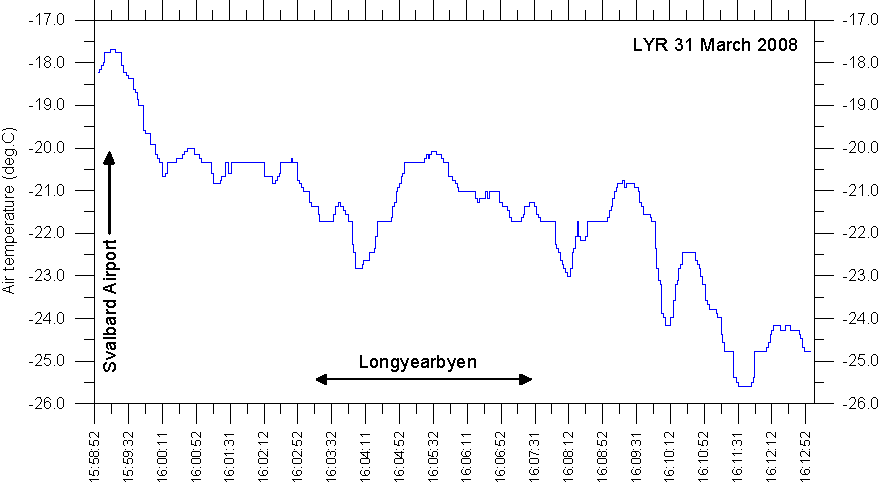Longyearbyen UHI experiment, March 31, 2008
Open Climate4you homepage

Longyearbyen March 31, 2008 16:15 PM (not corrected for summer time), looking WNW from the northern end of
the lake Isdammen (see map below). The sky was almost clear, with a few local
clouds forming over the fjord. The wind
was weak from southeasterly direction, 0.5-3 m/s. The large building in the
distance to the right is the main hangar at Svalbard Ariport. Compare with map below.
The general weather
situation, measurement equipment and measurement route
The air temperature was about -20oC, and the wind weak from southeasterly direction, 0.5-3 m/s, but with local deviations (see map below). The sky was almost clear. The ground surface was covered by snow. The nearby fjord was ice free, with the exception of a 5-50 m wide zone with new icew along the coast. A thermistor was attached to the roof of a car (c. 1.5 m above terrain), and temperatures were logged at 2 sec. intervals. The time given in the diagrams below are not corrected for summer time. The measurements were carried starting at Svalbard Airport in the upper left of the map below, driving SE along the coast to the town, making a roundtour here, before proceding SE into the lower part of the major valley Adventdalen.
Longyearbyen
is the worlds northernmost town and is located at 78o17'N 11o20'E,
in central

Topographic map showing Longyearbyen and Svalbard Airport (Svalbard Lufthavn). The red line shows the measurement route March 31, 2008, starting at the Airport and ending in the lower part of the valley Adventdalen to the SE. In between, a detour was made in the central part of the town as shown. The wind was weak, 0.5-3 m/s, from south easterly direction, but with local deviations (blue arrows). The fjord was ice free. The map section measures c. 11 km west to east.
Results

Result
of temperature measurements along the route Svalbard Airport - Longyearbyen
-Adventdalen, March 31, 2008. The official Svalbard meteorological station is
located at the airport. Se map above for reference.
Interpretation of results
The whole area was snowcovered. The sun was below the skyline formed by the mountains, and albedo effects caused by buildings and roads for that reason presumably not very important.
The registered air temperatures show an overall falling trend towards SE along the main measurement route. Near the airport, where the official Svalbard meteorological station is located, air temperatures are relatively high (about -18oC), which is interpreted as the result of the onshore airflow from SE across the ice free fjord. Further towards SE, this local warming effect diminishes, and colder air (about -25oC) draining out of the valley Adventdalen dominates. The temperature difference between the Airport and Adventdalen is about 8oC, representing the open water effect (OWE) at this particular time. In between, the local heat island effect of the town Longyearbyen is only weakly developed. The maximum UHI effect appears to be about +0.5oC at the time of the experiment. The local cold trough recorded within Longyearbyen (16:04) corresponds to the position of the main valley axis, where cold air masses is draining NNE from the glacier at the valley head.
The
existence of an urban heat island effect in a relatively small settlement as
Longyearbyen may come as a surprise. This is, however, not the first time this
has been observed in the Arctic; see, e.g., Hinkel
et al. 2003.